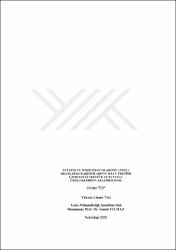| dc.contributor.advisor | Yılmaz, İsmail | |
| dc.contributor.author | Top, Cengiz | |
| dc.date.accessioned | 2022-04-06T06:49:49Z | |
| dc.date.available | 2022-04-06T06:49:49Z | |
| dc.date.issued | 2020 | |
| dc.identifier.uri | https://tez.yok.gov.tr/UlusalTezMerkezi/TezGoster?key=Eb5EkakJlp3olBdo_wNEGetyCRSV0YnCtHPeN6aPQJp1buu2dpDHgcXPPjQFpqLK | |
| dc.identifier.uri | https://hdl.handle.net/20.500.11776/4295 | |
| dc.description.abstract | Günümüzde artan toplum bilinci, mevcut ürünlerin içeriğini sorgulamak veya ne kullanılarak üretildiğini bilmek gerek dini gerek ise sağlık yönünden sonuçlarının araştırılmasına neden olmuştur. Özellikle son yıllarda vegan tüketiminin artması, firmaların yeni vegan ürünler çıkarmasına neden olmuştur. Ayrıca mevcut ürünlerin vegan formülasyonları oluşturulmaktadır. Jelly yumuşak şekerlemelerde hayvansal bağ dokudan elde edilen jelatin kullanılmaktadır. Jelatinin gerek sığırdan gerek ise domuzdan elde edilebilmesi helal ürün olma açısından da tüketicilerde soru işaretleri oluşturmaktadır. Bu çalışmada hem vegan ürün elde etmek hemde helalliği sorgulanmayacak bir jelly yumuşak şekerleme elde etmek amacıyla patates ve mısır nişastası kullanılarak 7 adet formülasyon oluşturulmuştur. Formülasyonlarda nişasta oranı ve çeşidi değişken olup, diğer hammaddeler sabit tutulmuştur. Elde edilen ürünler tekstürel ve duyusal açıdan analiz edilmiştir. Patates ve mısır nişastası kullanılan jelly ürünlerinde renk açısından birbirleri arasında herhangi bir fark bulunamamıştır. Su aktivitesi açısından sadece patates nişastası kullanılarak üretilen ürünler istenilen değer aralığında sonuç vermiştir. Tekstür analizlerinden yapışkanlık değerleri en yüksek olan örnekler patates nişastası kullanılan ürünler iken, sertlik değerleri en yüksek olan örnekler ise mısır nişastası kullanılan örneklerdir. Duyusal analizler 20 uzman panelist tarafından yapılmış olup 7 farklı formülasyonla yapılan örneklerin birbirlerine yakın puanlar aldığı gözlemlenmiştir. Jelatinli jelly yumuşak şekerlemeleri ile kıyaslama yapıldığında genel beğeni kabul edilebilir bir seviyede olduğu tespit edilmiştir. | en_US |
| dc.description.abstract | Today, increasing public awareness, questioning the content of existing products, knowing what or what they are produced by using, has led to the search for the results of both religious and health aspects. Especially in recent years, increasing vegan consumption has caused companies to produce new vegan products. Also, vegan formulations of the present products are formed. In jelly soft candies, gelatine obtained from animal connective tissue is used. The fact that gelatine can be obtained from both cattle and pigs is also a question mark in terms of being a halal product. 7 formulations were formed using potato and corn starch to obtain both vegan products and also to obtain a jelly soft confection without questioning halality. The starch content and variety in the formulations are variable and the other raw materials are kept constant. The obtained products were analyzed in terms of textural and sensory aspects. No difference was found in color of jelly products using potato and corn starch. In terms of water activity, products produced using only potato starch yielded the desired value range. The samples with the highest stickiness values were the products with potato starch and the samples with the highest hardness values were the corn starch samples. Sensory analyzes were conducted by 20 expert panelists and it was observed that samples made with 7 different formulations scored close to each other. Compared to gelatine jelly soft candies, the overall rating was found to be acceptable. | en_US |
| dc.language.iso | tur | en_US |
| dc.publisher | Tekirdağ Namık Kemal Üniversitesi | en_US |
| dc.rights | info:eu-repo/semantics/openAccess | en_US |
| dc.subject | Gıda Mühendisliği | en_US |
| dc.subject | Food Engineering | en_US |
| dc.title | Patates ve mısır nişastalarının farklı oranlarda karışımlarının jelly üretimi üzerindeki tekstür ve duyusal özelliklerinin araştırılması | en_US |
| dc.title.alternative | Investigation of textures and sensory characteristics of jelly production of mixtures potato and corn starches in different ratios | en_US |
| dc.type | masterThesis | en_US |
| dc.department | Enstitüler, Fen Bilimleri Enstitüsü, Gıda Mühendisliği Ana Bilim Dalı | en_US |
| dc.identifier.startpage | 1 | en_US |
| dc.identifier.endpage | 71 | en_US |
| dc.institutionauthor | Top, Cengiz | |
| dc.relation.publicationcategory | Tez | en_US |
| dc.identifier.yoktezid | 629615 | en_US |



















